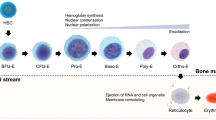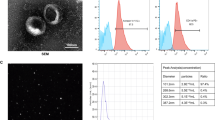Abstract
The role of the endocannabinoid system in haematopoietic cells is not completely understood. We investigated whether human erythroleukemia (HEL) cells were able to bind, metabolise and transport the main endocannabinoids, anandamide (AEA) and 2-arachidonoylglycerol (2-AG). We also investigated whether AEA or 2-AG could modulate HEL differentiation. Although able to internalise both endocannabinoids, HEL cells had the machinery to metabolise 2-AG only, since they were devoid of the enzymes needed to synthesise and degrade AEA. Nonetheless, the intracellular transport of exogenous AEA might be required to activate the vanilloid receptors, with yet unknown implications for vascular biology. On the contrary, 2-AG appeared to play a role in lineage determination. Indeed, 2-AG itself drove HEL cells towards megakaryocytic differentiation, as it enhanced expression of β3 integrin subunit, a megakaryocyte/platelet surface antigen, and glycoprotein VI, a late marker of megakaryocytes; in parallel, it reduced the amount of messenger RNA encoding for glycophorin A, a marker of erythroid phenotype. All these effects were mediated by activation of CB2 cannabinoid receptors that triggered an extracellular signal-regulated kinase-dependent signalling cascade. In addition, classical inducers of megakaryocyte differentiation reduced 2-AG synthesis (although they did not affect the binding efficiency of CB2 receptors), suggesting that levels of this endocannabinoid may be critical for committing HEL cells towards the megakaryocytic lineage.






Similar content being viewed by others
Abbreviations
- HEL:
-
human erythroleukaemia
- AEA:
-
anandamide
- 2-AG:
-
2-arachidonoylglycerol
- CB1 :
-
type-1 cannabinoid receptor
- CB2 :
-
type-2 cannabinoid receptor
- NAPE-PLD:
-
N-acyl-phosphatidylethanolamines-hydrolyzing phospholipase D
- FAAH:
-
fatty acid amide hydrolase
- TRPV1:
-
transient receptor potential channel vanilloid receptor subunit 1
- DAGL:
-
sn-1-specific diacylglycerol lipase
- MAGL:
-
monoacylglycerol lipase
- RTX:
-
resinferatoxin
- CP55,940:
-
5-(1,10-dimethyheptyl)-2-[1R,5R-hydroxy-2R-(3-hydroxypropyl)-cyclohexyl]phenol
- SR141716:
-
N-piperidino-5-(4-chlorophenyl)-1-(2,4-dichlorophenyl)-4-methyl-3-pyrazole-carboxa-mide
- SR144528:
-
[N-[(1S)-endo-1,3,3-trimethy-1-bicyclo [2.2.1]-heptan-2-yl]5-(4-choro-3-methyl-phenyl)-1-(4-methyl-benzyl)-pyrazole-3-carboxamide]
- OMDM1:
-
(R)-N-oleoyl-(1′-hydroxybenzyl)-2′-ethanolamin
- NarPE:
-
(N-arachidonoyl-phosphatidylethanolamine
- 2-OG:
-
2-oleoyl-glycerol
- DAG:
-
sn-1-stearoyl-2arachidonoyl-glycerol
References
Bari M, Battista N, Fezza F, Gasperi V, Maccarrone M (2006) New insights into endocannabinoid degradation and its therapeutic potential. Mini Rev Med Chem 6:257–268
Di Marzo V (2006) A brief history of cannabinoid and endocannabinoid pharmacology as inspired by the work of British scientists. Trends Pharmacol Sci 27:134–140
Egertova M, Cravatt BF, Elphick MR (2003) Comparative analysis of fatty acid amide hydrolase and CB1 cannabinoid receptor expression in the mouse brain: evidence of a widespread role for fatty acid amide hydrolase in regulation of endocannabinoid signaling. Neuroscience 119:481–496
Van Sickle MD, Duncan M, Kingsley PJ, Mouihate A, Urbani P, Mackie K, Stella N, Makriyannis A, Piomelli D, Davison JS, Marnett LJ, Di Marzo V, Pittman QJ, Patel KD, Sharkey KA (2005) Identification and functional characterization of brain stem cannabinoid CB2 receptors. Science 310:329–332
Okamoto Y, Morishita J, Tsuboi K, Tonai T, Ueda N (2004) Molecular characterization of a phospholipase D generating anandamide and Its congeners. J Biol Chem 279:5298–5305
Battista N, Gasperi V, Fezza F, Maccarrone M (2005) The anandamide membrane transporter and the therapeutic implications of its inhibition. Therapy 2:141–150
McKinney MK, Cravatt BF (2005) Structure and function of fatty acid amide hydrolase. Annu Rev Biochem 74:411–432
Van der Stelt M, Di Marzo V (2004) Endovanilloids. Putative endogenous ligands of transient receptor potential vanilloid 1 channels. Eur J Biochem 271:1827–1834
Bisogno T, Howell F, Williams G, Minassi A, Cascio MG, Ligresti A, Matias I, Schiano-Moriello A, Paul P, Williams EJ, Gangadharan U, Hobbs C, Di Marzo V, Doherty P (2003) Cloning of the first sn1-DAG lipases points to the spatial and temporal regulation of endocannabinoid knockout in the brain. J Cell Biol 163:463–468
Dinh TP, Carpenter D, Leslie FM, Freund TF, Katona I, Sensi SL, Kathuria S, Piomelli D (2002) Brain monoglyceride lipase participating in endocannabinoid inactivation. Proc Natl Acad Sci USA 99:10819–10824
Hermann A, Kaczocha M, Deutsch DG (2006) 2-Arachidonoylglycerol (2-AG) membrane transport: history and outlook. AAPS J 8:E409–412
Piomelli D (2003) The molecular logic of endocannabinoid signaling. Nat Rev Neurosci 4:873–884
Jorda MA, Rayman N, Tas M, Verbakel SE, Battista N, van Lom K, Lowenberg B, Maccarrone M, Delwel R (2004) The peripheral cannabinoid receptor Cb2, frequently expressed on AML blasts, either induces a neutrophilic differentiation block or confers abnormal migration properties in a ligand-dependent manner. Blood 104:526–534
Pacher P, Batkai S, Kunos G (2005) Cardiovascular pharmacology of cannabinoids. Handb Exp Pharmacol 168:599–625
Maccarrone M, Bari M, Menichelli A, Del Principe D, Finazzi-Agrò A (1999) Anandamide activates human platelets through a pathway independent of the arachidonate cascade. FEBS Lett 447:277–282
Maccarrone M, Bari M, Del Principe D, Finazzi-Agrò A (2003) Activation of human platelets by 2 arachidonoylglycerol is enhanced by serotonin. Thromb Haemost 89:340–347
Maccarrone M, Bari M, Battista N, Finazzi-Agrò A (2002) Estrogen stimulates arachidonoylethanolamide release from human endothelial cells and platelet activation. Blood 100:4040–4048
Galve-Roperh I, Aguado T, Rueda D, Velasco G, Guzman M (2006) Endocannabinoids: a new family of lipid mediators involved in the regulation of neural cell development. Curr Pharm Des 12:2319–2325
Matias I, Gonthier MP, Orlando P, Martiadis V, De Petrocellis L, Cervino C, Petrosino S, Hoareau L, Festy F, Pasquali R, Roche R, Maj M, Pagotto U, Monteleone P, Di Marzo V (2006) Regulation, function, and dysregulation of endocannabinoids in models of adipose and beta-pancreatic cells and in obesity and hyperglycemia. J Clin Endocrinol Metab 91:3171–3180
Jorda MA, Lowenberg B, Delwel R (2003) The peripheral cannabinoid receptor Cb2, a novel oncoprotein, induces a reversible block in neutrophilic differentiation. Blood 101:1336–1343
Akashi K, Traver D, Miyamoto T, Weissman IL (2000) A clonogenic common myeloid progenitor that gives rise to all myeloid lineages. Nature 404:193–197
Papayannopoulou T, Nakamoto B, Kurachi S, Nelson R (1987) Analysis of the erythroid phenotype of HEL cells: clonal variation and the effect of inducers. Blood 70:1764–1772
Tabilio A, Rosa JP, Testa U, Kieffer N, Nurden AT, Del Canizo MC, Breton-Gorius J, Vainchenker W (1984) Expression of platelet membrane glycoproteins and alpha-granule proteins by a human erythroleukemia cell line (HEL). EMBO J 3:453–459
Savini I, Catani MV, Arnone R, Rossi A, Frega G, Del Principe D, Avigliano L (2007) Translational control of the ascorbic acid transporter SVCT2 in human platelets. Free Radic Biol Med 42:608–616
Maccarrone M, Barboni B, Paradisi A, Bernabo N, Gasperi V, Pistilli MG, Fezza F, Lucidi P, Mattioli M (2005) Characterization of the endocannabinoid system in boar spermatozoa and implications for sperm capacitation and acrosome reaction. J Cell Sci 118:4393–4404
Hillard CJ, Edgemond WS, Jarrahian A, Campbell WB (1997) Accumulation of N-arachidonoylethanolamine (anandamide) into cerebellar granule cells occurs via facilitated diffusion. J Neurochem 69:631–638
de Lago E, Ligresti A, Ortar G, Morera E, Cabranes A, Pryce G, Bifulco M, Baker D, Fernandez-Ruiz J, Di Marzo V (2004) In vivo pharmacological actions of two novel inhibitors of anandamide cellular uptake. Eur J Pharmacol 484:249–257
Pertwee RG (1997) Pharmacology of cannabinoid CB1 and CB2 receptors. Pharmacol Ther 74:129–180
Sugiura T, Kondo S, Kishimoto S, Miyashita T, Nakane S, Kodaka T, Suhara Y, Takayama H, Waku K (2000) Evidence that 2-arachidonoylglycerol but not N-palmitoylethanolamine or anandamide is the physiological ligand for the cannabinoid CB2 receptor. Comparison of the agonistic activities of various cannabinoid receptor ligands in HL-60 cells. J Biol Chem 275:605–612
Maccarrone M, Bari M, Menichelli A, Giuliani E, Del Principe D, Finazzi Agrò A (2001) Human platelets bind and degrade 2-arachidonoylglycerol, which activates these cells through a cannabinoid receptor. Eur J Biochem 268:819–825
Marshall CJ (1995) Specificity of receptor tyrosine kinase signaling: transient versus sustained extracellular signal-regulated kinase activation. Cell 80:179–185
Wu H, Shen HW, Wu TF, Brass LF, Sung KC (2002) Extracellular signal-regulated kinases and g protein-coupled receptors in megakaryocytic human erythroleukemia cells: selective activation, differential regulation, and dissociation from mitogenesis. J Pharmacol Exp Ther 300:339–345
Woessmann W, Zwanzger D, Borkhardt A (2004) ERK signaling pathway is differentially involved in erythroid differentiation of K562 cells depending on time and the inducing agent. Cell Biol Int 28:403–410
Siemens J, Zhou S, Piskorowski R, Nikai T, Lumpkin EA, Basbaum AI, King D, Julius D (2006) Spider toxins activate the capsaicin receptor to produce inflammatory pain. Nature 444:208–212
Rabellino EM, Levene RB, Leung LL, Nachman RL (1981) Human megakaryocytes. II. Expression of platelet proteins in early marrow megakaryocytes. J Exp Med 154:88–100
Acknowledgements
This work was supported by grants from Ministero dell’Università e della Ricerca (PRIN 2004), from Ministero della Salute (R.C. 2005), from Fondazione della Cassa di Risparmio di Teramo (TERCAS contract 2005) and from Regione Piemonte -Ricerca Sanitaria Finalizzata 2004 (AB).
Author information
Authors and Affiliations
Corresponding author
Additional information
Maria Valeria Catani and Filomena Fezza contributed equally to the study.
Luciana Avigliano and Mauro Maccarrone are equally senior authors.
Electronic supplementary material
Below is the link to the electronic supplementary material
ESM Fig S2
(PDF 127 KB)
ESM Fig S4
(PDF 205 KB)
ESM Fig S5
(PDF 172 KB)
ESM Fig S6
(PDF 588 KB)
Rights and permissions
About this article
Cite this article
Catani, M.V., Fezza, F., Baldassarri, S. et al. Expression of the endocannabinoid system in the bi-potential HEL cell line: commitment to the megakaryoblastic lineage by 2-arachidonoylglycerol. J Mol Med 87, 65–74 (2009). https://doi.org/10.1007/s00109-008-0406-3
Received:
Revised:
Accepted:
Published:
Issue Date:
DOI: https://doi.org/10.1007/s00109-008-0406-3




